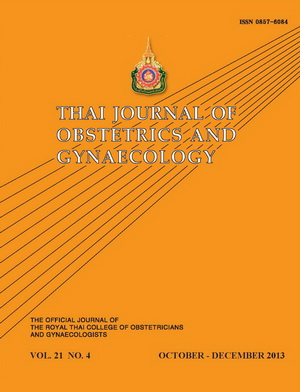Risk of Malignancy Index for a Diagnosis of Ovarian Malignancy
Main Article Content
Abstract
Objective: To calculate the optimal cut-off point for the risk of malignancy index (RMI) in the diagnosis of ovarian malignancy.
Materials and Methods: A retrospective study was conducted. We included women with adnexal masses who underwent elective surgery at Chonburi Hospital from January 2010 to December 2011. Data collected were age, menopausal status, serum CA 125, ultrasound findings, histopathology of masses, and stage of ovarian cancer. The RMI was obtained from multiplying the scores of menopausal status, serum CA 125, and ultrasonographic features. Primary outcome was the optimal value of RMI as well as its sensitivity, specificity, positive predictive value (PPV) and negative predictive value (NPV) to predict malignancy. Secondary outcomes were the association of each component of RMI and status of malignancy.
Results: One hundred and fifty-seven women met criteria; 61 cases (38%) were malignant and 96 (62%) were benign. We found the optimal RMI to predict malignancy was 257, with a sensitivity of 70.21%, specificity of 85.42%, PPV of 75.36% and NPV of 81.85%. Higher serum CA 125 levels and ultrasound findings (solid part and ascites) independently correlated with malignancy, while age and menopausal status gave poor correlation with diagnosis.
Conclusion: The optimal cut-off point of RMI to predict malignancy was 257. CA 125 and ultrasound features of solid area and ascites were independent factors determining malignancy.

